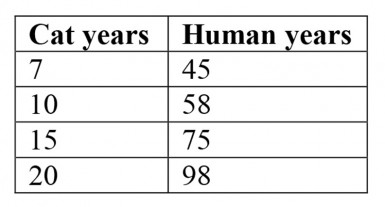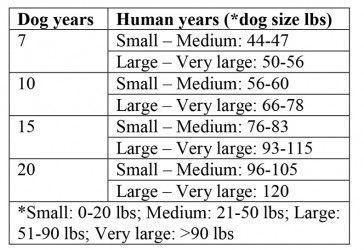So, today as promised, we embark upon a theme which is not so traumatic as the last series of articles dealing with pet euthanasia. In fact, one can argue that we should have dealt with canine and feline geriatrics before euthanasia, since (often) the latter follows the former.
Simply put, geriatrics is a branch of medicine that deals with problems and diseases associated with old age and aging. Immediately the question arises. What, generally speaking, is old? And, when we focus on our more common pets – what is an old dog/cat? Research carried out for this article reveals that there is some difference of opinion, not to say confusion.
If I were to ask you about canine chronology, for example, what is the relationship of human age to that of a dog, ie, how many human years are equal to one dog year, you would probably answer seven to one – seven human years being equivalent to one year of a dog’s life. That’s how we were taught and we accepted these figures, not only because they appeared in textbooks, but also because the figures just “looked right.” Well, now research scientists say that the 7:1 ratio is not correct.
 05Experts at the University of Pennsylvania’s School of Veterinary Medicine are following the calculations made by a French veterinarian, one Dr A Le Beau, whose findings, relative to the ratio between dog years and human years, they think are much more accurate.
05Experts at the University of Pennsylvania’s School of Veterinary Medicine are following the calculations made by a French veterinarian, one Dr A Le Beau, whose findings, relative to the ratio between dog years and human years, they think are much more accurate.
The reference table goes like this:
3 dog months = 5 human years
6 dog months = 10 human years
When the dog is a year old that is most likely equivalent to a human that is 15 years old.
At 2 years of age, that is equal to 24 human years.
Four (4) dog years = 32 human years
Six (6) dog years = 40 human years
Eight (8) dog years = 48 human years
Ten (10) dog years = 56 human years
As the dog gets older, the equivalency changes a bit. Then the table shows:
14 dog years = 72 human years
18 dog years = 91 human years
21 dog years = 106 human years
The American Veterinary Medical Association has come up with the following charts for cats and dogs (middle aged – senior citizen):
These guideline figures are liable to be changed because pets are living longer now than ever before, mostly due to improved veterinary research which leads to enhanced care and better dietary prescriptions. Perhaps columns like this one and TV shows and films like Marley and the plethora of books and radio programmes about companion animal care all combine to make the pet owner more knowledgeable about his pet’s welfare. Vets also are now armed with scientific literature which greatly helps the small animal practitioner to face the special needs of older pets.
Of course, I must emphasise that the figures above emanate from research carried out in affluent societies. The multiple stressors a dog in the developing countries has to endure on a day-to-day basis must have an effect on the figures. Heat and extreme humidity levels (five degrees from the equator and below sea level), poor nutrition (unbalanced diets), diseases, ectoparasitic (ticks, fleas, lice, etc) infestations and endoparasitic (worms) burdens all conspire to shorten a dog’s/cat’s life span.
What the figures and general considerations mentioned above do illustrate is that your feline/canine ward becomes a ‘senior citizen’ before you do. Pets age faster than people. In Guyana this is mostly true. An eight-year-old dog is not middle aged. He is old! Having said that, I know that dogs and cats which have been fed well and vaccinated and those which experience optimal care and preventative treatments can still run around chasing cats at 10 years of age.
We will continue next week with some other interesting facts relative to canine/feline geriatrics.










